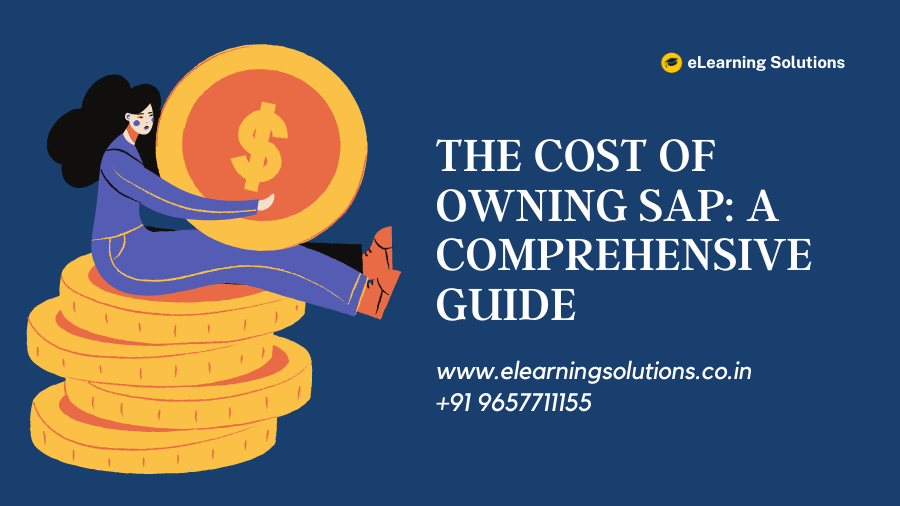As a leading enterprise resource planning (ERP) software, SAP offers extensive functionality and a robust ecosystem for businesses of all sizes. However, the cost of owning SAP can be significant and requires careful consideration before implementation. This guide aims to provide a comprehensive overview of the various cost components associated with SAP ownership, helping you make informed decisions about your business investment.
SAP S4 Hana Interview Questions
Types of SAP Licenses
- Named User Licenses:
- Tied to specific users with designated access.
- Tailored for individual roles and responsibilities.
- Package Licenses:
- Bundled licenses for specific modules or functionalities.
- Suitable for organizations with diverse user roles.
How to Become a SAP Consultant ?
Types of Cost of Owning SAP
Initial Costs:
- Software License: The initial cost of an SAP license is based on factors like the number of users, modules, and deployment model (on-premise, cloud, or hybrid).
- Implementation Services: Implementation involves data migration, system customization, and user training. Costs depend on project complexity and chosen partner.
- Hardware and Infrastructure: On-premise deployments require hardware infrastructure and ongoing maintenance. Cloud-based options offer a flexible alternative but involve subscription fees.
- Customization and Development: Additional features and integrations might require custom development, incurring additional costs.
Ongoing Costs:
- Maintenance and Support: SAP provides annual maintenance contracts offering updates, bug fixes, and technical support.
- User Training and Development: Ongoing training ensures employee proficiency and adoption of the system.
- Additional Modules and Upgrades: As your business needs evolve, additional modules or upgrades might be necessary, often involving additional costs.
- Integration Costs: Integrating SAP with other systems may require additional software and resources.
Hidden Costs:
- Change Management: Implementing SAP can disrupt existing workflows and require significant change management efforts.
- Data Migration: Migrating data from legacy systems to SAP can be complex and time-consuming, with potential hidden costs.
- Lost Productivity: During implementation and initial adoption, employees might experience decreased productivity due to learning and adjustments.
- Security and Compliance: Maintaining a secure SAP environment requires ongoing investments in cybersecurity tools and expertise.
Factors Affecting Cost:
- Business Size and Complexity: Larger and more complex businesses typically incur higher SAP costs due to increased software licenses, implementation complexity, and customization needs.
- Industry and Regulatory Requirements: Industry-specific regulations and compliance requirements might necessitate additional modules or customization, impacting costs.
- Deployment Model: On-premise deployments require significant upfront hardware and infrastructure investments, while cloud-based options offer a flexible alternative but involve recurring subscription fees.
- Implementation Partner: Choosing an experienced and reliable SAP implementation partner can significantly impact project success and cost efficiency.
Factors Impacting Implementation Costs
- Scope of Implementation:
- Full-suite implementations incur higher costs than phased rollouts.
- Customization complexity influences expenses.
- System Complexity:
- Integrating SAP with complex existing systems increases costs.
- Addressing unique business processes may require additional customization.
- Vendor Selection:
- Choosing experienced SAP implementation partners can affect costs.
- Vetting vendors based on expertise and reputation is crucial.
Cost Optimization Strategies:
- Start with a Clear Business Case: Define your specific needs and desired outcomes to ensure you implement the right modules and avoid unnecessary costs.
- Choose the Right Deployment Model: Consider your budget, IT resources, and future scalability needs before choosing between on-premise, cloud, or hybrid deployments.
- Negotiate Software Licenses: Leverage your existing business relationships and industry partnerships to negotiate favorable license terms with SAP.
- Standardize and Minimize Customization: Minimize custom development to reduce implementation and maintenance costs. Opt for standard configurations whenever possible.
- Utilize Free Training Resources: Take advantage of SAP’s free training resources and online communities to minimize training costs.
- Plan for Long-Term Maintenance: Factor in ongoing maintenance and support costs when budgeting for SAP ownership.
- Leverage Technology and Automation: Utilize automation tools and technologies to reduce manual tasks and optimize operational efficiency.
Conclusion:
The cost of owning SAP can vary significantly depending on individual business needs and implementation choices. By understanding the various cost components, carefully evaluating your requirements, and implementing cost-optimization strategies, you can maximize the return on your SAP investment and drive business success.
Additional Resources:
- SAP Licensing Guide: https://help.sap.com/doc/saphelp_nw73ehp1/7.31.19/en-us/48/c43926ca64581de10000000a42189c/content.htm
- SAP Implementation Roadmap: https://blogs.sap.com/2019/11/08/sap-activate-methodology-roadmaps-update-for-sap-s-4hana-1909/
- SAP Cost Optimization Strategies: https://blogs.sap.com/tag/finance-transformation/
Remember, the key to managing the cost of owning SAP lies in careful planning, strategic implementation, and ongoing optimization efforts. By making informed decisions and leveraging available resources, you can harness the power of SAP to achieve significant business value and competitive advantage.



 WhatsApp us
WhatsApp us